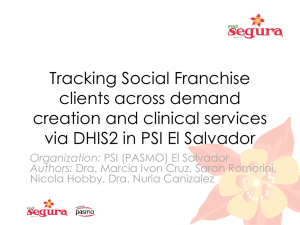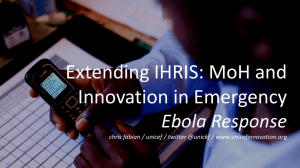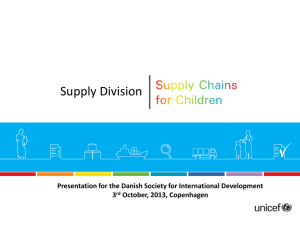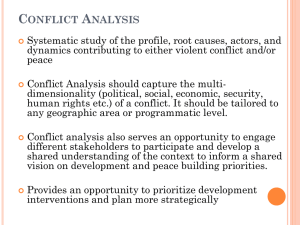File - 6th Global Health Supply chain summit
advertisement
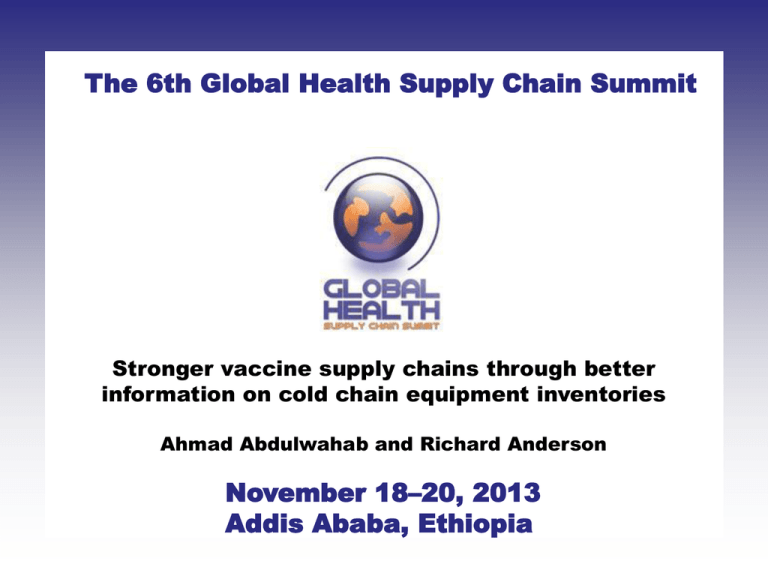
The 6th Global Health Supply Chain Summit Stronger vaccine supply chains through better information on cold chain equipment inventories Ahmad Abdulwahab and Richard Anderson November 18–20, 2013 Addis Ababa, Ethiopia About PATH PATH transforms global health through innovation. Page 2 18 November 2013 Acronyms CCEM CDC CCEI CCL CHAI DHIS2 EPI HISP HMIS MOH PRRINN UNICEF Page 3 Cold Chain Equipment Manager tool US Centers for Disease Control and Prevention Cold chain equipment inventories Cold chain and logistics Clinton Health Access Initiative District Health Information Software 2 Expanded Programme on Immunization Health Information Systems Programme Health management information system Ministry of health Partnership for Reviving Routine Immunization in Northern Nigeria United Nations Children’s Fund 18 November 2013 A new tool to support EPI: DHIS2/CCEI Web-based cold chain equipment inventories 18 November, 2013 Ahmad Abdulwahab,PRRINN-MNCH Richard Anderson, UW, PATH Sophie Newland, PATH Fahad Pervaiz, UW Overview Objective Introduce DHIS2/CCEI, a new tool that can support a stronger cold chain and logistics systems by increasing access and use of cold chain equipment inventory data for decision-making at all levels of the vaccine supply chain. Structure Slides 6–9 provide an overview and framework for CCEI. Slides 10–11 introduce data standards for CCEI. Slides 12–15 discuss web-based systems and the DHIS2/CCEI module. Slides 16-19 summarize the deployment in Northern Nigeria Assumptions New vaccines are being added to the vaccine supply chain and insufficient cold chain equipment is a major, preventable bottleneck. Better equipment management and planning increases the efficiency and effectiveness of the vaccine supply chain. Investing in tools and systems that provide data for management decisions will benefit staff throughout the cold chain and logistics system. An open-source software platform that is web-based offers EPI an opportunity to increase data use and access. Page 5 18 November 2013 What questions do we want to answer with CCEI? Where are refrigerators and facilities located? What are the cold chain capacity requirements of each facility? What is the size, age, and functional status of a country’s cold chain equipment inventory? How many refrigerators need to be repaired, replaced, or repositioned? How may old refrigerators need to be replaced? Are existing refrigerators big enough for the facility’s vaccine volumes? What is the new cold chain equipment list and budget needed to support planned introduction of new vaccines? Page 6 18 November 2013 Cold chain equipment inventories: Data sets 1. Health facility data 2. Refrigerators, freezers, cold room, cold box data 3. Vaccine and equipment reference data Page 7 18 November 2013 Cold chain equipment inventories (CCEI) A brief history In 2007, EPI, PATH, UNICEF, and WHO staff started a collaboration to develop a CCEI tool to help countries develop evidence-based multiyear equipment plans, CCEM. CCEM has since informed the design of a new web-based CCEI tool, DHIS2/CCEI. Draft CCEI Data Standards UNICEF CCL Taskforce provides the consensus-building forum for drafting CCEI data standards. The way forward EPI/UNICEF/PATH/HISP Initially working with EPI teams in Ghana, Kenya, Laos, and Nigeria, UNICEF, PATH, and HISP will validate and release the DHIS2/CCEI module as part of global DHIS2 platform, v2.13 (anticipated, Q1 2014). Re-engineering of CCEM onto DHIS2 platform In collaboration with HISP India, PATH translated lessons learned from CCEM design and deployments into specifications for a web-based CCEI tool that can integrate with a national HMIS system, DHIS2. Power of integration and extensibility DHIS2/CCEI will be customized and maintained by MOH as an integrated HMIS module and extended to support temperature, monitoring, repair services, and other EPI requirements. DHIS2/CCEI: Web-based CCEI tool integrated with HMIS 2007 2008 CCEM: Stand-alone Microsoft Access-based CCEI tool 2009–2010 2011 2012 2015 2014 CCEM 2.1 Functionality and interface expanded based on feedback. CCEM 1.0 Uganda EPI, WHO/AFRO, UNICEF and PATH validate CCEM 1.0. UNICEF/PATH MOU Launch of CCEM design and development. Page 8 2013 CCEM in 10 countries Kenya, Malawi, Zimbabwe Deployment of CCEM with support from WHO, UNICEF, CHAI, and CDC. CCEM has been deployed in ten countries in Africa, Europe, Latin America, and Southeast Asia. Anticipate continued use by country EPI teams uninterested or unable to support web-based CCEI. 18 November 2013 Contributions Cold chain equipment inventory data standards: • CCEI standards vetted by UNICEF CCL Taskforce. Web-based CCEI tool: • Cold chain equipment inventories added to DHIS2. Vision for cold chain information system: • Linking multiple capabilities to support immunization supply chain. Deployment: • Page 9 PRRINN CCEI/DHIS2 deployment in Northern Nigeria. 18 November 2013 Developing a data standard for CCEI • • • • • Page 10 Agree on what information needs to be included. Agree on the representation. Allow different applications to share data and interoperate. Give countries flexibility in choice of tools. Draft reviewed by UNICEF CCL Taskforce. 18 November 2013 Why data standards? “[Data Standard] can avoid vendor lock-in, support new modular solutions which interoperate with an installed base of technologies and devices, and open the door for lower-cost providers (some based in developing countries themselves) to take part in health technology innovation without needing to create and manufacture an entirely new platform.” Masum H, Lackman R, Barleson K. Developing global health technology standards: what can other industries teach us? Globalization and Health. 2013;9(1):49. Available at: http://www.globalizationandhealth.com/content/9/1/49 Page 11 18 November 2013 Web-based information systems Centralize data management: • • Robust, high-performance database (cloud or server). Link to national health information system. Distribute access: • • • Page 12 Enable update of CCEI. Access to management information at all levels of health system. Integrate with mobile devices and reporting. 18 November 2013 District Health Information Software 2 (DHIS2) • Web-based health information system developed by HISP and deployed globally. • Sophisticated system for health indicator reporting and data visualization. • Highly customizable by domain and country. Page 13 18 November 2013 Cold chain module for DHIS2 • Release as a component of DHIS2. • Under development by HISP India. • Release target of January 2014. Page 14 18 November 2013 CCEI vision Align multiple software tools supporting immunization: • • Conversion between different inventory tools: spreadsheets, PC applications, and web-based tools. Share data across applications: modeling tools, logistics management. Facilitate the process of building a national CCEI: • Tools for data integration and cleaning. Extension of CCEI data standards to other cold chain domains: • Remote temperature monitoring. • Page 15 Reporting of 30-day temperature recorders in Laos with UNICEF. Equipment maintenance. 18 November 2013 Background on Northern Nigeria • • PRRINN-MNCH works in 4 Northern Nigerian states of Jigawa, Katsina, Yobe and Zamfara. Combined population of the 4 states is about 20 million people (92 LGAs, 976 Political wards with about 3,500 HFs) • • Page 16 Region has the worst health indices –immunization inclusive in the country • GAVI also plans to provide 1,400 direct drive solar New vaccines introduction refrigerators to the country currently ongoing country wide 18 November 2013 Information system requirements • • • Huge demand for up to date data on CCE for effective planning and monitoring Although DHIS2 is widely used in the country, data on CCE and vaccines stock not part of the datasets (only coverage data) Strong need for integration of Cold chain (and vaccines) data with immunization reporting • Page 17 Addition of CCEI module will accelerate the adoption of the DHIS2 18 November 2013 Implementation in DHIS2 • • • • • Page 18 Flexibility of the DHIS makes it easy to add-on the CCEI module Datasets customized to meet the needs of the country and the states Data-elements in the IRP matched with those of the DHIS2 Incorporation of CCEI and vaccines data linked to immunization coverage data has improved the acceptability of the DHIS. Limitations – no major ones 18 November 2013 Country opportunities …For deployment of the CCEI • Ongoing introduction of Pentavalent vaccines • Ongoing plan to supply CCEs – 1st tranche of 1400 direct drive SR (GAVI) due by February 2014. • Saving One Million Lives (SOML) campaign • Development of Logistics Management system Page 19 18 November 2013 All photos in this presentation unless otherwise indicated are courtesy of PATH. Support for this project is made possible by the generous support of the American people through the United States Agency for International Development (USAID) under the terms of the HealthTech Cooperative Agreement # AID-OAA-A-11-00051. The contents are the responsibility of PATH and do not necessarily reflect the views of USAID or the US Government.

